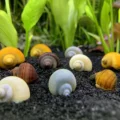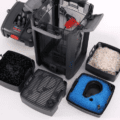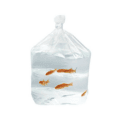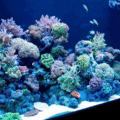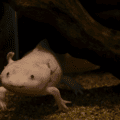Most marine organisms require a large amount of space to thrive. Despite this, I was still able to dig up some of the best saltwater fish species that can be housed in a smaller 20-gallon tank. Some of these saltwater fish ideas can even be included in a nano reef setup and are beginner-friendly in terms of care.
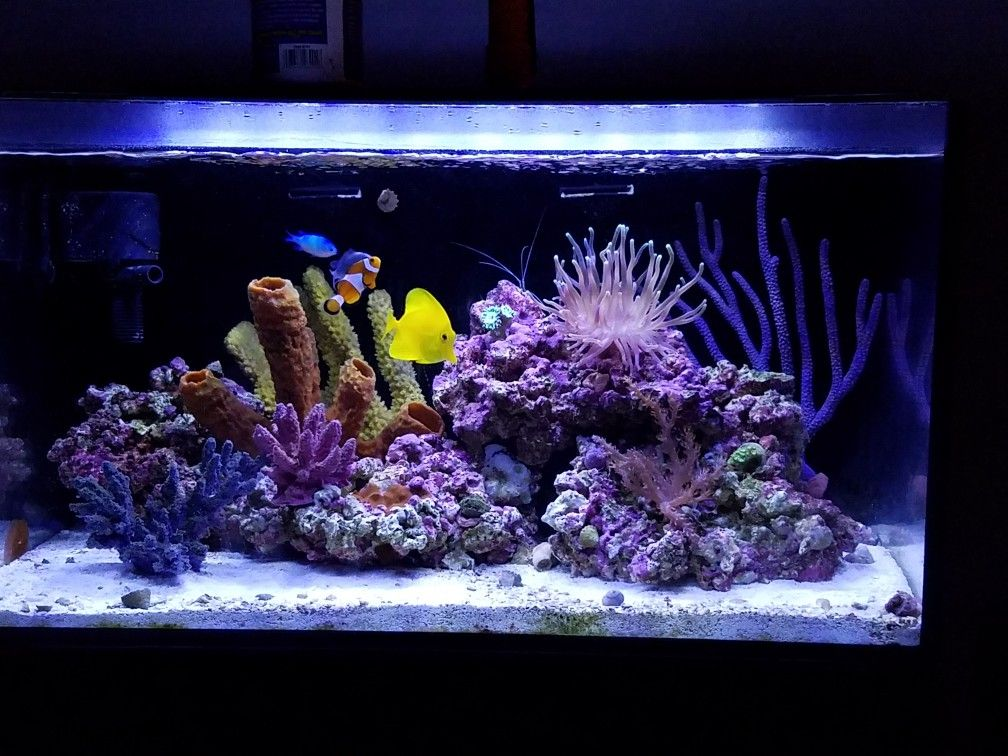
Figuring out what fish you can cram in such a limited space can be frustrating, so I’ve created a list with twelve of the best saltwater fish species that can comfortably live in your new 20-gallon saltwater aquarium.
Let’s dive in and see which these species are.
12 Saltwater Fish Ideas for Your 20-Gallon Tank
When starting a saltwater aquarium, going big is always a good idea.
Bigger tanks give you much more room to play with different fish species than nano tanks and are generally easier to maintain.
Going smaller doesn’t mean you can’t create an equally impressive saltwater aquarium.
Quite the contrary, there are plenty of stocking ideas for a 20-gallon tank that put some 55-gallon setups to shame.
Curious to see how you can turn the tides in your favor?
Here are some interesting saltwater fish ideas for a 20-gallon aquarium:
1. Red Firefish Goby – Nemateleotris magnifica
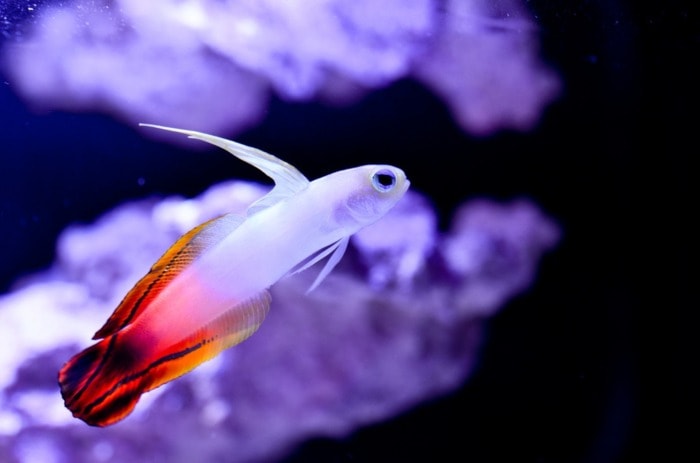
| Adult size: | 3 inches (7.6 cm) |
| Safe for corals: | Yes |
| Suitable for beginners: | Yes |
The firefish Goby is a great addition for anyone looking for a hardy fish that can thrive in a smaller environment.
Also known as Nemateleotris magnifica in the scientific community, these nano fish get to be only 3 inches at their biggest. The firefish goby is docile and will live peacefully in your coral reefs without picking at or disturbing them.
As a result of their shy nature, they require lots of hiding places and decorations where they can take a break. Apart from this, they’re relatively undemanding and have high compatibility with other species which makes them a suitable beginner saltwater fish.
Author’s note: The red firefish goby is known to jump out of its tank, so include a mesh netting over the top to ensure it doesn’t escape and hurt itself.
2. Clownfish – Amphiprion Ocellaris

| Adult size: | 3.5 inches (9 cm) |
| Safe for corals: | Yes |
| Suitable for beginners: | Yes |
Finding a more popular saltwater fish than the Ocellaris clownfish from the Amphiprion genus would be hard. This famous marine fish is one of the biggest on the list at 3.5 inches (9 cm) in size.
Even though clownfish have a symbiotic relationship with anemonefish in nature, they can easily survive by themselves in an aquarium setting.
Clownfish are coral-friendly, but might occasionally annoy some of them with their consistent presence.
They are easy to care for and don’t require a lot of extra work, so I would definitely recommend them as a must-have for any beginner who is starting a 20-gallon aquarium. For more information on the lifespan of these gorgeous fish, you can check this article.
3. Yellowtail Damselfish – Chrysiptera parasema
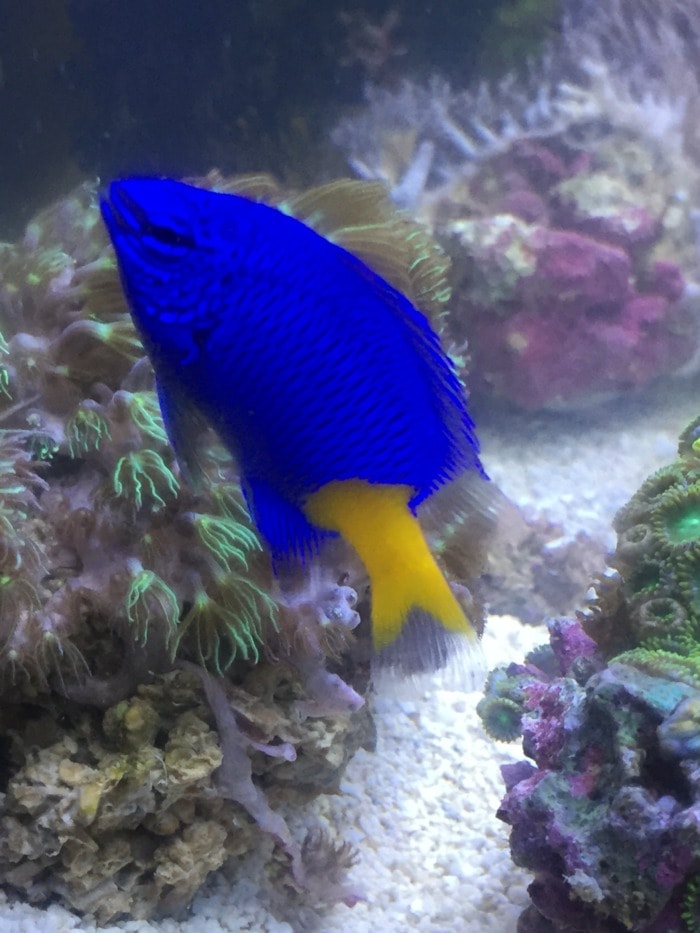
| Adult size: | 2.7 inches (7 cm) |
| Safe for corals: | Yes |
| Suitable for beginners: | Yes |
The Yellowtail Damselfish is another excellent choice for anyone looking to spice up their tank. This striking blue and yellow fish is only about 2.7 inches its biggest, but that doesn’t mean it can’t put up a fight. These semi-aggressive fish can be very territorial and can be difficult to deal with when kept in a community.
Fortunately, their hostility doesn’t extend to corals, making them excellent for reef setups.
Author’s note: To avoid fights within the tank, only house saltwater damselfish with other aggressive fish that are similar in size and temperament.
4. Gumdrop Coral Croucher – Caracanthus madagascariensis
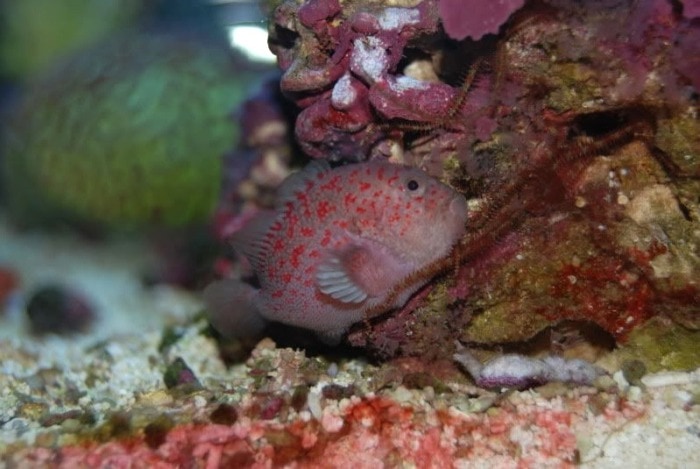
| Adult size: | 2 inches (5 cm) |
| Safe for corals: | Yes |
| Suitable for beginners: | No |
Gumdrop Coral Crouchers (Caracanthus madagascariensis) is another great, reef-safe option for a 20-gallon tank.
These tiny, unique fish possess a humble character, but this venomous fish is not as harmless as you think, their dorsal fin contains venom which can hurt you, so be careful when handling them.
Even though they are generally safe for corals, Gumdrop Crouchers can cause some damage during spawning.
They don’t necessarily qualify as beginner-friendly because of their specific needs when being fed and the potential danger of handling them.
5. Pygmy Coral Croucher – Caracanthus unipinna
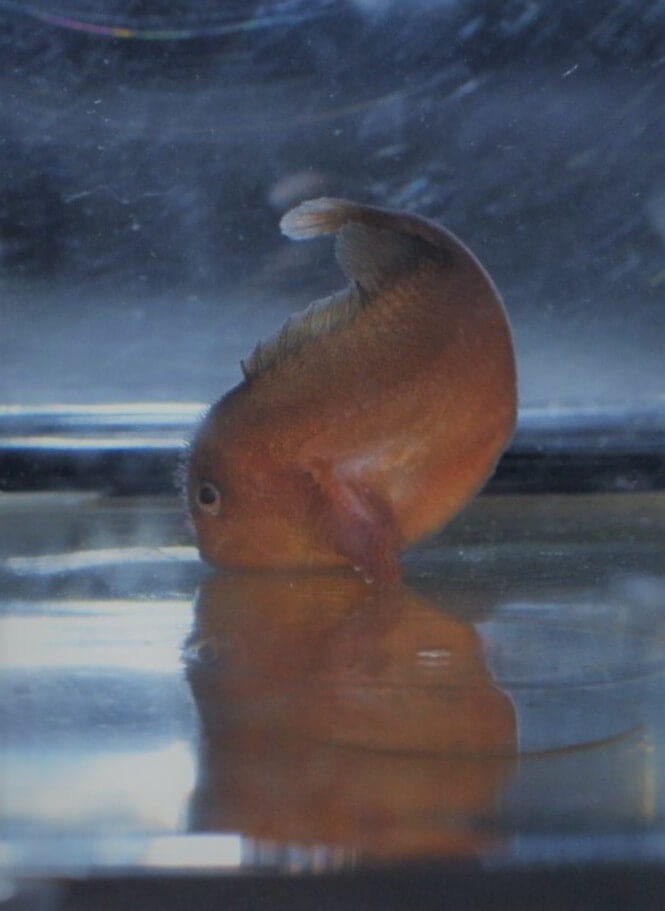
| Adult size: | 1.5 inches (3.8 cm) |
| Safe for corals: | Yes |
| Suitable for beginners: | No |
The pygmy coral croucher, also known as Caracanthus unipinna, is one of the smallest saltwater fish on this list at only 1.5 inches long. Even though they can be described as reserved, these venomous fish can fend for themselves when needed.
As long as you keep them with peaceful fish, these pygmy fish won’t cause any violence.
As their name implies, these nano saltwater fish use corals as a form of cover and won’t cause them any harm.
They are not the best choice for beginner aquarists because they have venomous fins and need to be hand-fed. If this is something that you believe you can manage, then enjoy adding one of these unique-looking fish to your saltwater aquarium.
6. Twin Spot Goby – Signigobius biocellatus
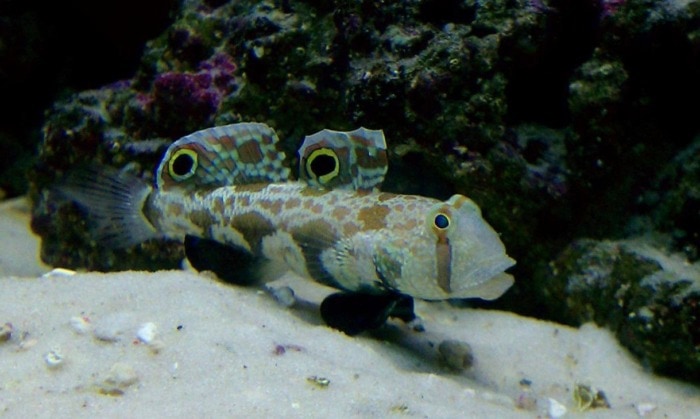
| Adult size: | 3.5 inches (8.9 cm) |
| Safe for corals: | Yes |
| Suitable for beginners: | No |
Twin Spot Gobies can be a bit difficult to care for if you’re a beginner. In nature, these unique bottom-dwelling fish feed on the microfauna found in the sand, hence their nickname sand sifting goby
Due to this, they have to be weaned off their naturally established diet in order to feed them typical fish food.
Signigobius biocellatus is safe for reefs, but their constant sand shifting may disturb the corals a little bit.
The Twin Spot Goby is compatible with most other fish species of their size, but can become territorial and exhibit aggression towards conspecifics.
7. Court Jester Goby – Koumansetta rainfordi
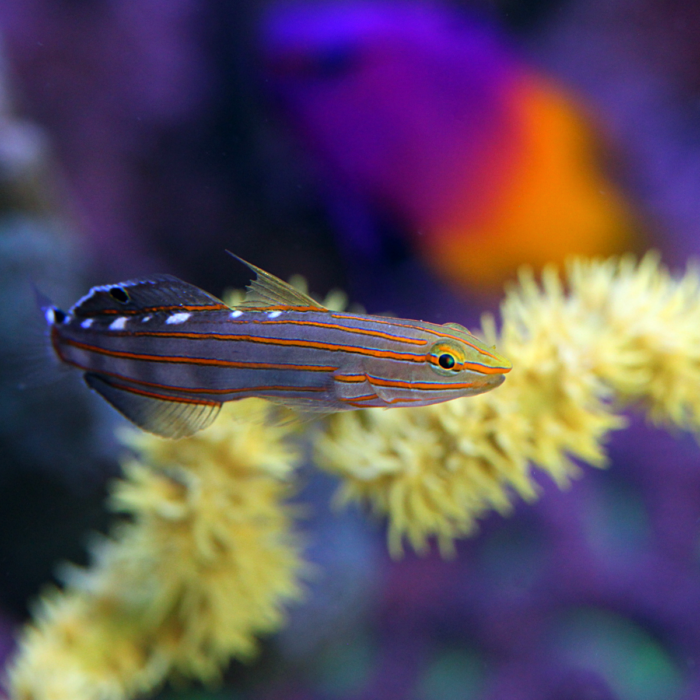
| Adult size: | 2.8 inches (7.1 cm) |
| Safe for corals: | Yes |
| Suitable for beginners: | No |
The court jester goby or Koumansetta rainfordii is incredibly peaceful and doesn’t take up too much room.
They are safe for coral reefs and will not disturb or harm them. Despite their comical name, this sand-sifting goby does not like to be the center of attention and can be pretty timid.
Jester Gobies are not suitable for beginners due to their capricious dietary preferences.
They might not always accept what you give them, which can be stressful for you and them.
However, if you are looking for a challenge, the court jester goby can be a great way to test your aquarium proficiency.
8. Longspine Cardinalfish – Zoramia leptacantha
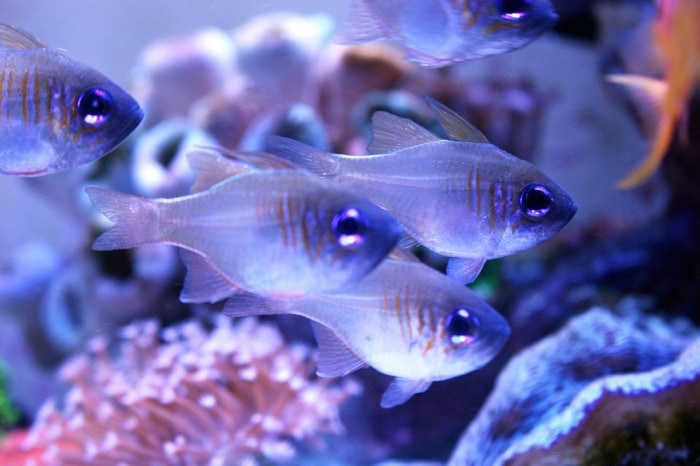
| Adult size: | 2.5 inches (6.3 cm) |
| Safe for corals: | Yes |
| Suitable for beginners: | Yes |
The Longspine Cardinalfish (Zoramia leptacantha), is a see-through fish that caps at about 2.5 inches max in size.
They are friendly towards other fish but may fight each other to establish a hierarchy.
They’re also usually timid, especially when their numbers are scarce.
They’re schooling fish, so try putting at least 2-3 in your aquarium to make them feel more at ease.
Longspine Cardinalfish are found in reefs in the Indian Ocean so you can rest assured they won’t disturb your corals.
9. Sharknose Goby – Gobiosoma evelynae
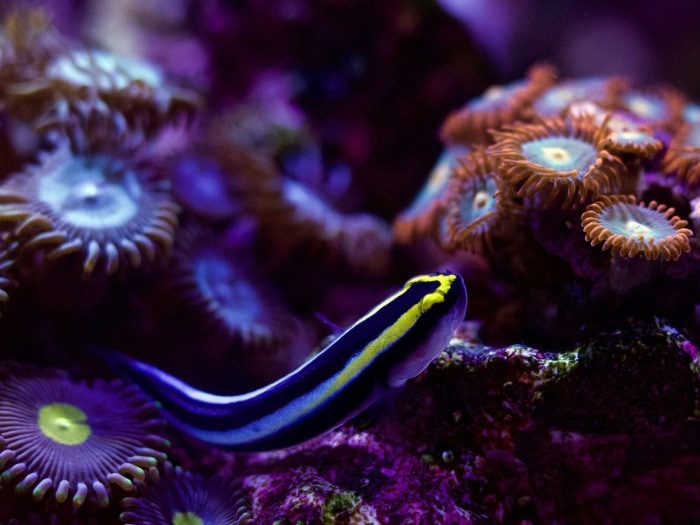
| Adult size: | 1.8 inches (4.6 cm) |
| Safe for corals: | Yes |
| Suitable for beginners: | Yes |
Sharknose gobies are energetic, visually appealing pet fish that get along with other fish species just as well as they do with corals.
What’s more interesting about these tiny fish, however, is their symbiotic relationship with larger aquatic species.
In the wild, a Sharknose goby will feed on the dead skin and ectoparasites found on bigger fish. Even though this might seem trivial, understanding the interaction between cleaner fish and their clients might provide us with insight into the structuring and functioning of coral reefs.
Their easygoing and helpful nature makes them excellent candidates for anyone just starting a small saltwater tank.
10. Clown Goby Fish – Gobiodon okinawae

| Adult size: | 1.5 inches (3.8 cm) |
| Safe for corals: | No |
| Suitable for beginners: | Yes |
The clown goby fish (Gobiodon okinawae) is a vibrantly colored yellow fish that can shame even the brightest highlighter with its glow.
They are on the smaller side at only 1.5 inches max adult size.
These nano fish are technically reef safe but tend to pick on stony coral with small polyps.
So when adding coral, avoid SPS-type coral if you plan on including a clown goby fish in your tank. They are better suited with LPS corals.
If you’re setting up your first saltwater aquarium, these saltwater fish would be a great addition.
11. Flaming Prawn Goby Fish – Discordipinna griessingeri
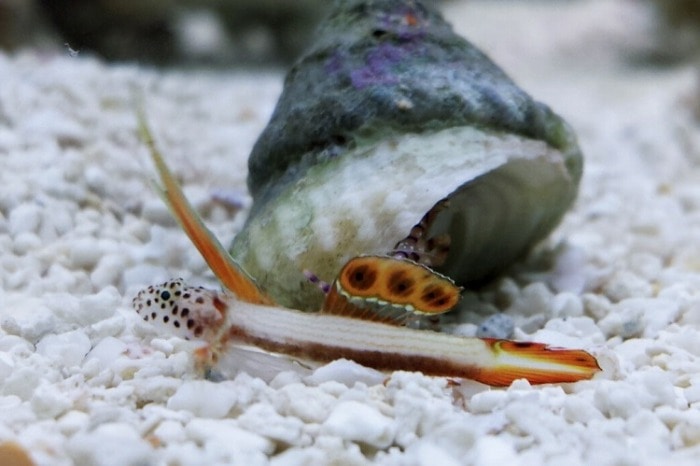
| Adult size: | 1 inch (2.54 cm) |
| Safe for corals: | Yes |
| Suitable for beginners: | No |
The flaming prawn goby, otherwise known as Discordipinna griessingeri is arguably the coolest and yet smallest fish on this list with a size of just 1 inch.
Based on the accounts I’ve heard from other people, these nano fish are elusive like ninjas.
They are safe for coral reefs and enjoy them so much that they spend most of their time hidden in the crevices.
These cool water saltwater fish are peaceful and prefer cool water, but are hard to spot most of the time, which can be disappointing for new tank owners.
Also, flaming prawn gobies are a bit pricier, so keep this in mind when making a budget for what fish you want.
Recommended Read: Sand Sifting Goby Fish (for a Clean Sandbed)
12. Tailspot Blenny – Ecsenius stigmatura
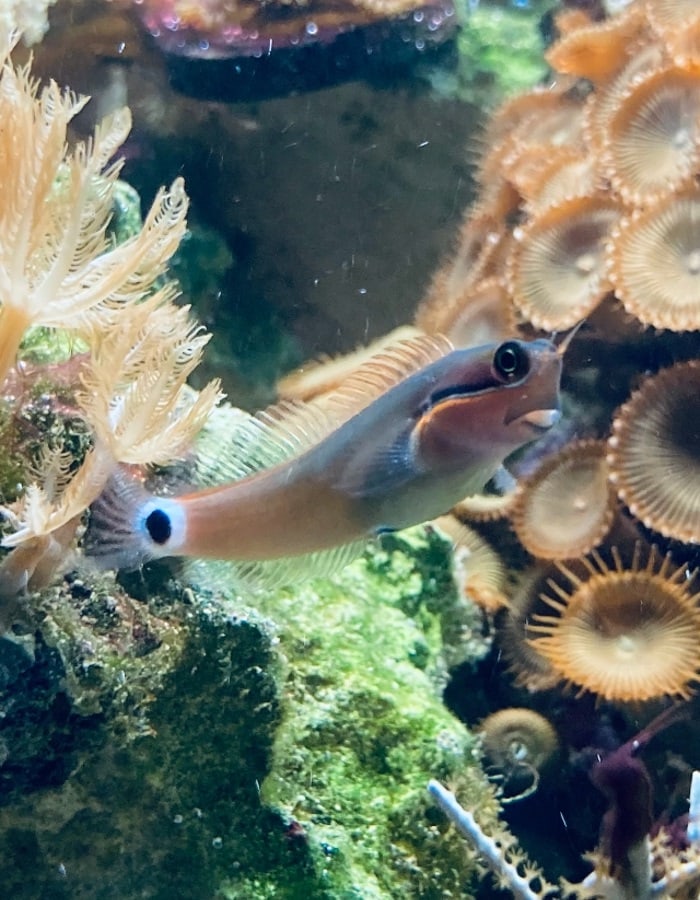
| Adult size: | 2.5 inches (6.3 cm) |
| Safe for corals: | Yes |
| Suitable for beginners: | Yes |
The last fish on the list is the tailspot blenny (Ecsenius stigmatura), a small yet social plant eater.
Its friendly personality makes the tailspot blenny a great pet fish that does well in a community tank.
It will not nip or disturb coral reefs, so you won’t have to worry about them causing trouble.
They are easy to care for and peaceful, so they are another excellent choice for anyone starting a small saltwater tank.
Blennies are also great algae eater, so they’re often used as saltwater cleaner fish due to their appetite for algae. The Tailspot Blenny is no exception to this as it adores eating green hair algae.
Even though they won’t be able to single-handedly clear an algae bloom, they can certainly help a lot.
Tailspot blennies are good beginner saltwater fish, but there are plenty more out there.
Which of these fish are suitable for a reef tank?
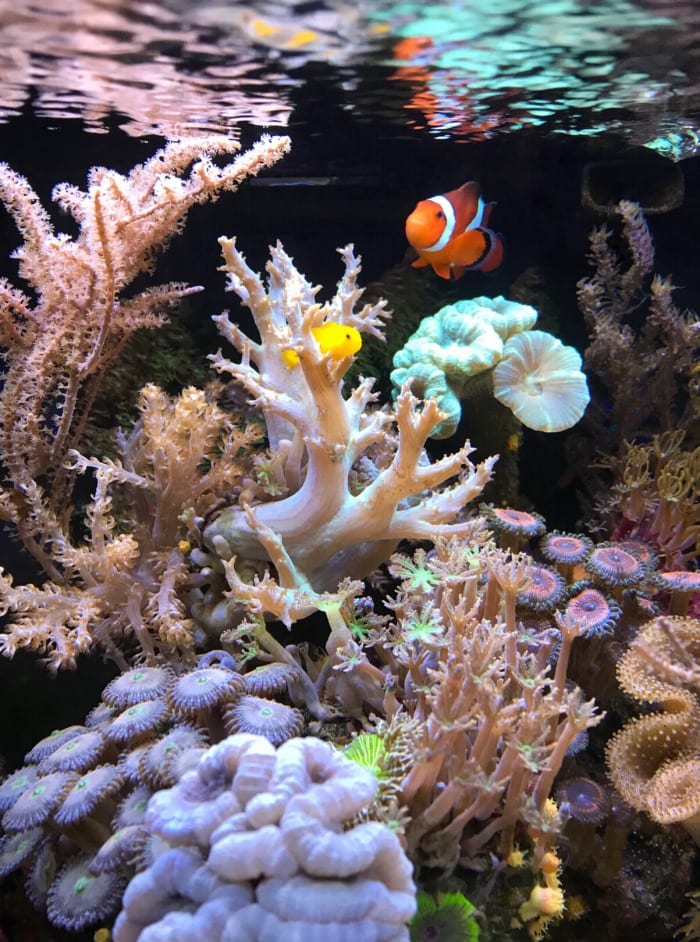
When stocking a 20-gallon long reef tank, you want to choose the members of your community wisely.
Even though most of the fish on this list are reef safe, some can’t be fully trusted around corals.
Coral compatibility is essential when considering fish for a nano reef tank.
If you’re a beginner, I would suggest the Sharknose goby, clownfish, and tailspot blenny.
All of these are reef safe fish and easy for beginners to care for while offering their unique personality to the tank.
Clownfish, for instance, have a symbiotic relationship with anemones which earns them protection in exchange for nutrients.
Tailspot blennies, on the other hand, change their color depending on the mood they’re in.
Unfortunately, no matter how captivating all of the entries on this list may seem, you’ll be unable to fit all of them in a single 20-gallon tank.
However, you’ll still be able to put in quite a few.
How many saltwater fish can you keep in a 20-gallon tank?
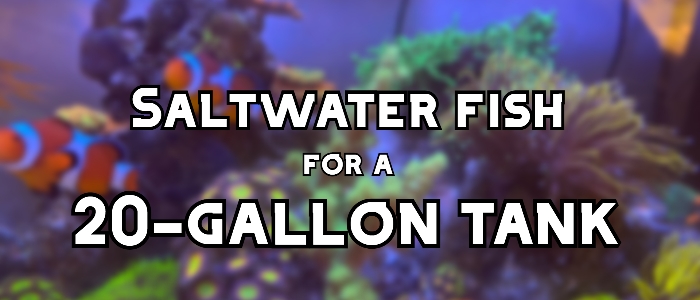
When calculating the number of fish they can put in their aquarium, many beginners go by the one inch of fish per one gallon of water rule.
However, this rule has long been debunked in the aquarium community because it uses fish length as a determining factor.
If we follow it, then we should be able to fit a 10-inch Blue Tang fish in a 10-gallon tank.
While this is technically possible, it will quickly lead to the demise of our poor tang since there will be too much waste. The aquarium bioload will be too high.
A more reliable way to estimate how many saltwater fish you can keep in a 20-gallon aquarium would be to measure the size of each fish in cubic inches and use it as a reference to find out how many gallons of water it needs.
This helps you estimate the stocking density for your 20-gallon tank.
How is this any different?
Let’s use a Gourami as an example.
A typical Gourami should have a body length of 5 inches, a height of 2½ inches, and be about ½ inch thick.
By multiplying these, we get a total body volume of 6.25 cubic inches.
This means we would need at least 6 gallons of water for a single gourami.
Even though this is a more accurate way to estimate the number of fish you can put in your aquarium, you should still exercise caution when using it.
Some fish might need more space because of their temperament, while others might require extra space because of their bioload.
Suggested to read next: Saltwater Fish Ideas for Stocking a 5-Gallon Tank
My Personal Favorites
When considering this list of saltwater fish, my favorites are the Sharknose goby and the Tailspot blenny for a few reasons.
They are a friendly combo of fish that help the tank by either cleaning the algae or removing parasites from other inhabitants.
They are also not big, and won’t take up too much space in your aquarium.
So if you’re looking for a good saltwater aquarium combo, these are the best saltwater fish ideas I would prioritize wanting to see in my tank.




